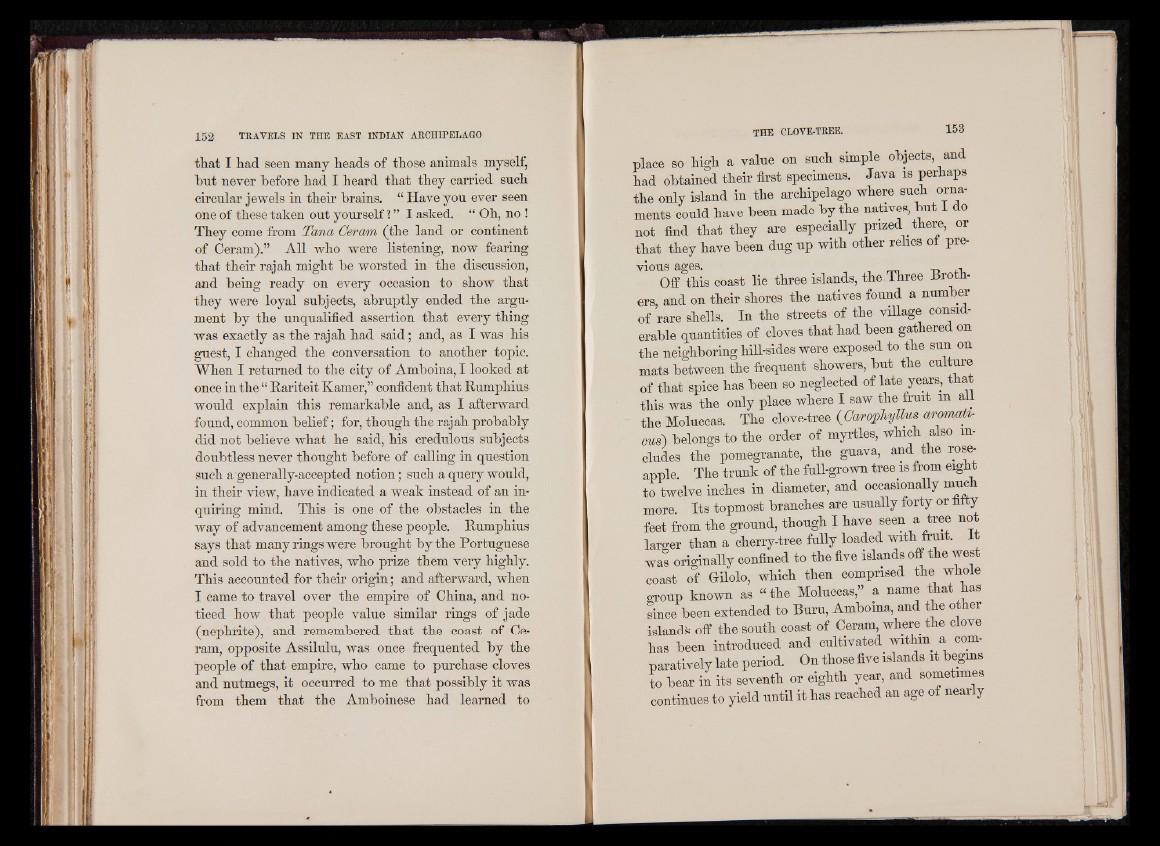
that I had seen many heads of those animals myself,
hnt never before had I heard that they carried such
circular jewels in their brains. “ Have yon ever seen
one of these taken out yourself ? ” I asked. “ Oh, no !
They come from Tana Ceram (the land or continent
of Ceram).” All who were listening, now fearing
that their rajah might be worsted in the discussion,
and being ready on every occasion to show that
they were loyal subjects, abruptly ended the argument
by the unqualified assertion that every thing
was exactly as the rajah had said; and, as I was his
guest, I changed the conversation to another topic.
When I returned to the city of Amboina, I looked at
once in the “ Rariteit Kamer,” confident that Rumphius
would explain this remarkable and, as I afterward
found, common belief; for, though the rajah probably
did not believe what he said, his credulous subjects
doubtless never thought before of calling in question
such a generally-accepted notion; such a query would,
in their view, have indicated a weak instead of an inquiring
mind. This is one of the obstacles in the
way of advancement among these people. Rumphius
says that many rings were brought by the Portuguese
and sold to the natives, who prize them very highly.
This accounted for their origin; and afterward, when
I came to travel over the empire of China, and noticed
how that people value similar rings of jade
(nephrite), and remembered that the coast of Ceram,
opposite Assilulu, was once frequented by the
people of that empire, who came to purchase cloves
and nutmegs, it occurred to me that possibly it was
from them that the Amboinese had learned to
place so high a value on such simple objects, and
had obtained their first specimens. Java is perhaps
the only island in the archipelago where such ornaments
could have been made by the natives, but I do
not find that they are especially prized there, or
that they have been dug up with other relics of previous
ages. , .a.
Off this coast lie three islands, the Three Brothers,
and on their shores the natives found a number
of rare shells. In the streets of the village considerable
quantities of cloves that had been gathered on
the neighboring hill-sides were exposed to the sun on
mats between the frequent showers, but the culture
of that spice has been so neglected of late years, that
this was the only place where I saw the fruit m all
the Moluccas. The clove-tree (Carophyllus aromah-
cus) belongs to the order of myrtles, which also includes
the pomegranate, the guava, and the rose-
apple The trunk of the full-grown tree is from eight
to twelve inches in diameter, and occasionally much
more. Its topmost branches are usually forty or fifty
feet from the ground, though I have seen a tree not
larger than a cherry-tree fully loaded with fruit. It
was originally confined to the five islands off the west
coast of Gilolo, which then comprised the whole
group known as “ the Moluccas,” a name that has
since been extended to Buru, Amboina, and the other
islands off the south coast of Ceram, where the clove
has been introduced and cultivated within a comparatively
late period. On those five islands it begins
to bear in its seventh or eighth year, and sometimes
continues to yield until it has reached an age of nearly